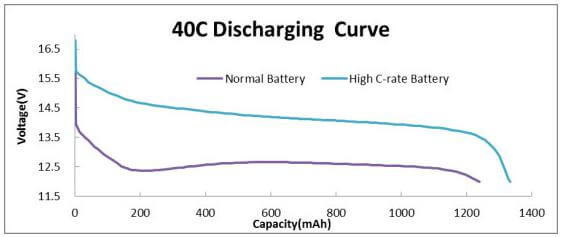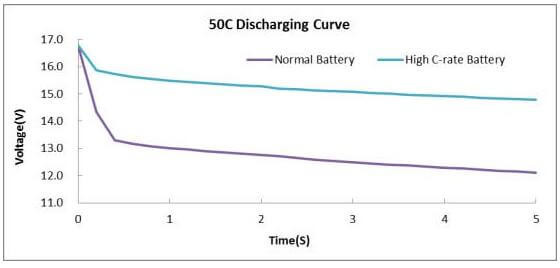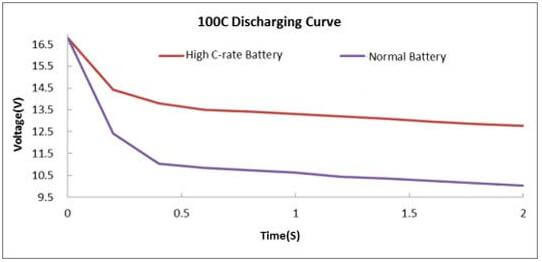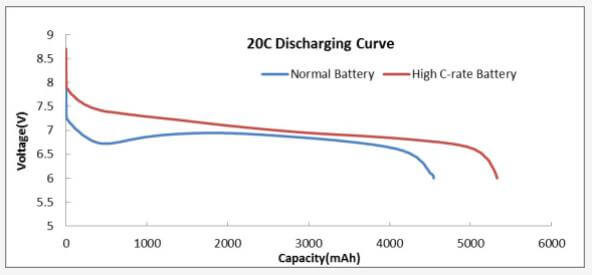High Rate Discharge Battery VS Normal Battery
Jul 17th 2019
What is high Rate discharge battery?
The high rate is representative of the charge and discharge capability of the lithium-ion polymer battery with respect to the ordinary rate. The high-rate battery is divided into a discharge rate and a charge rate, and "C" is used to indicate the ratio of the charge and discharge current of the battery, that is the rate. For example, a 1200 mAh battery, 0.2 C means 240 mA (0.2 mA of the 1200 mAh battery), and 1 C means 1200 mA (1 times rate of the 1200 mAh battery). Normally high discharge rate batteries can be fast charged. However, since lithium ions are embedded in the negative electrode graphite during charging, the process of inserting lithium ions into the positive electrode during the discharge process is difficult, so the fast charge ratio is generally lower than the discharge rate.
Why need high Rate discharge battery?
If the ordinary battery is fast charged, it is easy to cause lithium stripping of the negative electrode, which leads to an accelerated deterioration of the battery performance. In severe cases, the internal short circuit leads a fire explosion of the battery may occur. Most consumer applications require only 1C of battery, you should choose high rate battery that if you need higher discharge rates and faster charging times. With the development of various industries, higher discharge and faster-charging requirements for batteries have pushed the technical improvement and application of rate batteries. At present,high-rate batteries are widely used in aerial drones, agricultural plant protection drones, emergency start power supplies, model aircraft, power tools and etc.What are High discharge Battery Features?
- High performance in power, discharge, and life cycles due to stacking process. - Ability to achieve 150C pulse, 90C discharge for 2seconds, 45C continuous discharge, and 5C fast charging. - Provides better temperature stability and tolerance due to the allowance of higher discharge rate. - Ultra-thin characteristics, light weight, flexible size, flexible shapes, and ability to accommodate many applications. - With ultra-thin characteristics, small size, extremely light weight, High rate lithium polymer can be made into a variety of shapes and capacities of shaped batteries, thickness can reach 0.45mm;What is different between High Rate discharge battery and Normal battery?

40C Discharging Curve
In the figure, the battery of the same capacity continues to discharge the test curve under the same current (40C), it can be seen that the high-rate battery's discharge voltage is high, and the voltage drop is gentle, and more capacity is released.Due to the internal resistance of the high-rate battery is small, low loss during large current discharge, so the discharge voltage platform and capacity can keep great.
 In the figure, the pulse discharge test curves of the same capacity battery 50C 5S, 100C 2S, it can be seen that Grepow high discharge rate battery voltage is high, can support large current pulse discharge, the discharge voltage platform remains high, and can support large current discharge in short time.
In the figure, the pulse discharge test curves of the same capacity battery 50C 5S, 100C 2S, it can be seen that Grepow high discharge rate battery voltage is high, can support large current pulse discharge, the discharge voltage platform remains high, and can support large current discharge in short time.
 The above cycle life test curve shows the 1C charging of the high-rate battery of Grepow, which is discharged at 30C and 40C respectively,after 300 weeks cycled,the 30C battery discharge capacity retention rate remains above 93%,and the 40C battery discharge capacity retention rate keep above 85% ,all keep a high level.The larger the battery discharge current is,the more heat is generated inside the battery,and the attenuation of the battery will be larger,so the 40C battery discharge capacity retention rate is lower than the 30C battery.
The above cycle life test curve shows the 1C charging of the high-rate battery of Grepow, which is discharged at 30C and 40C respectively,after 300 weeks cycled,the 30C battery discharge capacity retention rate remains above 93%,and the 40C battery discharge capacity retention rate keep above 85% ,all keep a high level.The larger the battery discharge current is,the more heat is generated inside the battery,and the attenuation of the battery will be larger,so the 40C battery discharge capacity retention rate is lower than the 30C battery.

Normal Battery VS High C Rate Battery
Due to the high-rate battery use the electrode material which is favorable for high-rate discharge, the internal resistance design of the electrode is smaller than that of the ordinary battery,so the rate battery have high discharge platform,high discharge efficiency,and high output power and energy.
Fast Charge Curve
Fast charging battery 3C full only takes 25min, ordinary lithium battery 1C charging takes more than 80min, as fast charge curve, the charging time can save more than 60%.
